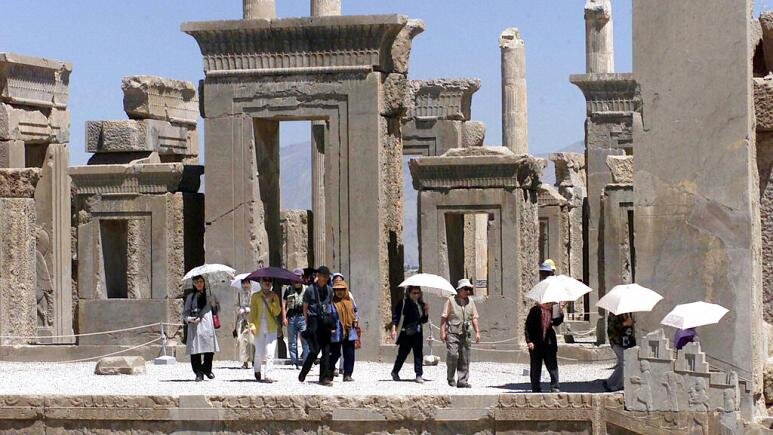Intl. museums, archeologist condemn Trump’s threat to hit Iranian cultural sites

TEHRAN – The Victoria and Albert Museum in London, the Fine Arts Museums of San Francisco, the American Alliance of Museums, and a renowned Polish archeologist have condemned U.S. President Donald Trump’s recent statements on threating to target Iranian cultural sites.
According to Artnet News, Tristram Hunt, the former politician who is now the director of the Victoria and Albert Museum in London, tweeted his dismay. Trump’s threats “must be condemned,” he wrote, “just as the bulldozing of Palmyra & significant heritage sites by ISIS was abhorrent.” Hunt adds: “This is a worrying step towards the normalization of cultural destruction as a war aim.” The V&A is planning a major exhibition of Persian art and design in the fall.
The renowned Polish archeologist Barbara Kaim, who specializes in the archaeology of Iran and Central Asia, compared Trump’s threats to that of a “barbarian.”
“I completely do not understand how modern man can let himself even just to think about destroying cultural goods,” Kaim says. “How is this different from some known ISIS activities?” she asks, referring to the cultural vandalism of Islamic extremists.
Thomas Campbell, the former director of the Metropolitan Museum of Art who is now at the helm of the Fine Arts Museums of San Francisco, has been unusually outspoken.
Campbell posted a powerful response on Instagram alongside a map of Iran’s most important heritage sites. He explained that normally museum directors “remain behind the scenes… But when the President of the United States inverts every value system our country previously stood for, and calls for destructive attacks against cultural sites in one of the oldest civilizations of the world, you have to speak out vehemently and urgently.”
The American Alliance of Museums also on Monday condemned the targeting of cultural sites for destruction.
“Our nation has a long history of safeguarding cultural resources, particularly in nations experiencing political turmoil and armed conflict. Strikes against cultural sites anywhere in the world are a threat to our global heritage and contradicts treaties signed by the United States to protect humankind’s cultural heritage in the 1954 Hague Convention for the protection of Cultural Property in the Event of Armed Conflict, the United Nations Security Council Resolution 2347, and 1972 UNESCO Convention Concerning the Protection of the World Cultural and Natural Heritage. We expect the United States Government to comply with international law and urge the U.S. Government to reaffirm its commitment to its longstanding practice of not targeting cultural sites during peace or wartime,” the AAM announced in an official statement.
Trump has threatened to target major cultural sites in Iran if the country retaliates after he ordered the assassination of Qasem Soleimani, a top Iranian military commander, by drone strike.
In a tweet on Saturday night, Trump warned that the U.S. will hit important cultural sites in Iran “very fast and very hard” should the Iranians kill any Americans or attack American assets.
Iran and the U.S. have been in a tense standoff ever since a U.S. drone strike killed the top commander shortly after he had arrived at Baghdad airport in Iraq on Friday.
Trump tweeted on Saturday that the U.S. has 52 Iranian locations within its sights. The president said that some of these sites are “at a very high level & important to Iran & the Iranian culture.” The number is symbolic. Fifty-two diplomats were seized in the U.S. embassy in Tehran in 1979 and held hostage during the Islamic Revolution.
While the U.S. has not named the targets on its radar, Iran has 22 cultural sites on the UNESCO World Heritage list, including the ruins of the ancient city of Persepolis, as well as the site of Imam Square, and its royal mosque in Isfahan, and the Chogha Zanbil complex. The country has numerous other important cultural sites, such as the historic Nasir al-Mulk in Shiraz.
Iran’s foreign minister Mohammad Javad Zarif responded to Trump on Sunday, also arguing that targeting cultural sites is a war crime, and writing that such a breach of international red lines is “a big(ly) ‘no no.’”
Pentagon rules out striking cultural sites
The Pentagon has distanced itself from Trump’s threat to target Iranian cultural sites.
Defence Secretary Mark Esper said on Monday the U.S. will “follow the laws of armed conflict.” When asked if that ruled out targeting cultural sites, Esper said pointedly: “That’s the laws of armed conflict.”
Esper acknowledged that striking cultural sites with no military value would be a war crime, putting him at odds with the president, who insisted such places would be legitimate targets, the New York Times reported.
“We will follow the laws of armed conflict,” Mr. Esper said at a news briefing at the Pentagon when asked if cultural sites would be targeted as the president had suggested over the weekend. When a reporter asked if that meant “no” because the laws of war prohibit targeting cultural sites, Mr. Esper agreed. “That’s the laws of armed conflict.”
AFM/MG
